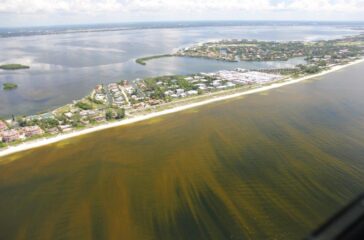As “red tides” bloom, citizen scientists help map ocean danger zones
Nearly every day, Florida resident Pradeepa Siva goes paddle boarding through Doctors Pass in Naples. The thin passageway between Moorings Bay and the Florida Gulf of Mexico is home to a couple of friendly dolphins, which Siva often sees on her outings.
But the journey is about more than exercise and wildlife sightings, because when Siva paddle boards she is also participating in a government-funded science project aimed at protecting public health as climate change brings warming ocean waters that contribute to rising incidences of a dangerous phenomenon known as the “red tide.”
Red tides occur when warming water and other factors spur the growth of a type of rust-colored algae known as Karenia brevis. The algae produces toxic compounds that can be harmful to humans as well as marine mammals and other sea life. Exposure to the algae can cause respiratory illnesses and other problems for people who are exposed, and, in rare occasions, be debilitating or even fatal.
 EWG
EWG